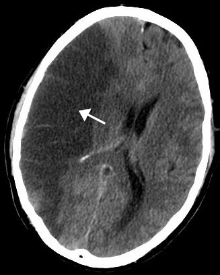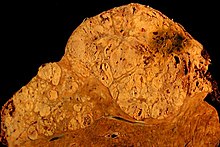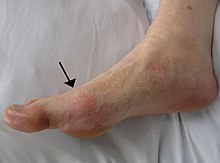비만 관련 질병성
Obesity-associated morbidity| 비만 관련 질병성 | |
|---|---|
 | |
| 비만은 사람들의 삶의 질에 부정적인 영향을 미치는 많은 의학적 합병증을 가지고 있다. | |
| 전문 | 내분비학(기타 전공) |
| 다음에 대한 시리즈 일부 |
| 인체중량 |
|---|
비만은 많은 만성적인 신체적, 정신적 질병의 중요한 위험 요인이다. 일반적으로 받아들여지는 견해는 과체중이 비만과 유사한 건강 문제를 야기하지만, 그 정도는 덜하다는 것이다.[1]
심장학
허혈성 심장병
비만은 협심증과 심근경색을 포함한 심혈관 질환과 연관되어 있다.[2][3] 2002년 한 보고서는 허혈성 심장질환의 21%가[1] 비만 때문이라고 결론내렸고 2008년 유럽의 합의는 그 수를 35%[4]로 제시하였다.
울혈성 심부전
비만이 있는 것은 남성의 심장마비 환자 중 약 11%, 여성의 14%와 관련이 있다.[5]
고혈압
고혈압 환자의 85% 이상이 25세 이상의 BMI를 가지고 있다.[5] 고혈압의 위험성은 정상체중과 비교했을 때 비만에서 5배나 높다. 비만과 고혈압 사이의 결정적인 연관성은 동물과 임상 연구를 이용하여 발견되었는데, 이는 비만 유도 고혈압에 대한 여러 가지 잠재적 메커니즘이 있음을 시사해 왔다. 이러한 메커니즘에는 레닌-안지오텐신-알도스테론 시스템의 활성화뿐만 아니라 교감신경계의 활성화도 포함된다.[6] 고혈압과 비만 사이의 연관성은 어린이들 사이에서도 잘 묘사되어 왔다.[7]
이상콜레스테롤 수치
비만은 LDL 콜레스테롤(나쁜 콜레스테롤) 증가와 HDL 콜레스테롤(좋은 콜레스테롤) 감소와 관련이 있다.[5][8]
심맥혈전증 및 폐색전증
비만은 정맥 혈전증의 위험을 2.3배 증가시킨다.[9][10]
피부과
비만은 스트레치 자국, 아칸토스병, 림프부종, 셀룰라염, 히르수티즘, 인터트리고의 발병과 관련이 있다.[11][12]
내분비

당뇨병
비만과 질병 사이의 가장 강력한 연결고리 중 하나는 제2형 당뇨병과 관련이 있다. 이 두 가지 조건은 1970년대 연구자들이 '비만'이라고 부르기 시작할 정도로 밀접한 관련이 있다.[5] 과도한 체중은 남성의 당뇨병 환자 64%, 여성의 당뇨병 환자 77%보다 뒤처진다.[13]
자네코마스티아
2009년 한 리뷰에 따르면 비만은 일부 개인에서 안드로겐이 에스트로겐으로 변하는 지엽적인 변화와 연관될 수 있다.[14]
위장
위내식 역류성 질환
몇몇 연구들은 GERD 증상의 빈도와 심각성이 비만인 사람들에게 더 높다는 것을 보여주었다.[15][16]
담석(갈돌)
NIH에 따르면, 비만은 담즙의 콜레스테롤의 양을 증가시키게 하고, 다시 돌이 형성될 수 있다.
생식계(또는 생식계)
다낭성 난소증후군(PCOS)
인슐린 저항성 때문에 다낭성 난소증후군(PCOS)과 함께 비만 위험이 높아진다. 미국에서는 PCOS 환자의 약 60%가 30보다 큰 BMI를 가지고 있다. PCOS가 비만의 원인이 되는지, 아니면 그 반대의 원인이 되는지는 여전히 불확실하다.[18]
불임
비만은 남녀 모두에게 불임으로 이어진다. 이것은 주로 여성의[5] 정상적인 배란을 방해하고 남성의 정자생식을 변화시키는 과도한 에스트로겐 때문이다.[19] 그것은 일차 불임의 6%를 유발하는 것으로 여겨진다.[5][20] 2013년에 비만이 남성의 과두증과 아즈오스피아의 위험을 증가시킨다는 결과가 나왔고, 승산비는 1.3이었다.[21] 병적으로 비만하면 승산비가 2.0으로 증가한다.[21]
임신 합병증
비만은 출혈, 감염, 산모의 입원 증가, 신생아 NICU 요건 증가 등 임신 중 많은 합병증과 관련이 있다.[22] 비만인 여성은 정상체중 여성에 비해 제왕절개 비율이 2배 이상 높다.[23] 비만 여성은 임신 전 출산과 저체중 영유아 위험도 높아졌다.[24]
선천적 결함
임신 중 비만인 사람들은 다음과 같은 다수의 선천성 기형을 가진 아이를 가질 위험이 더 크다. 예를 들어, 무음증, 척추간 이피다 같은 신경관 결함, 구순구개열을 포함한 심혈관 이상, 구순구개열, 구순구개열, 사지절감 이상, 수혈증 등을 포함한다.[25]
자궁내 태아 사망
모성 비만은 자궁 내 태아 사망의 위험 증가와 관련이 있다.[20]
신경학
스트로크
메랄지아 프레스티미카
Meralgia pasticimatica는 신경성 통증이나 허벅지의 저림이며, 때로는 비만과 관련이 있다.[26]
편두통
편두통과 비만은 합병증이 있다. 편두통의 위험은 BMI가 30 kg/m일2 때 50%, BMI가 35 kg/m일2 때 100% 상승한다.[27] 인과관계는 여전히 불명확하다.[28]
손목터널증후군
손목터널증후군 위험은 체질량지수가 1kg/m2 증가할 때마다 7.4%씩 증가한다.[29]
치매
비만인 사람은 정상체중보다 치매 비율이 1.4배 높다.[30]
특발성 뇌내 고혈압
특발성 뇌내 고혈압, 즉 두개골의 설명되지 않은 고혈압은 시력장애, 빈번한 심한 두통, 이명 등을 일으킬 수 있는 희귀한 질환이다. 그것은 비만 여성들에게서 가장 흔히 볼 수 있다.[31][32]
다발성 경화증
18세에 비만인 여성은 MS의 위험성이 2배 이상 증가한다.[33]
암(또는 종양)
많은 암들이 과체중이나 비만인 사람들에게 증가 빈도로 발생한다. 영국의 한 연구는 암의 약 5%가 과도한 체중 때문이라는 것을 발견했다.[34] 이러한 암에는 다음이 포함된다.
체질량지수(BMI)가 높으면 영국에서 자궁암의 41%와 담낭, 신장, 간, 대장암의 최소 10%를 포함한 10개의 흔한 암에 걸릴 위험이 더 높다.[36] 암 수술을 받는 사람들의 경우, 비만은 정상 체중의 합병증에 비해 큰 수술 후 합병증의 위험이 증가하는 것과도 관련이 있다.[37]
정신과
우울증
비만은 우울증과 관련이 있다.[5] 그 관계는 더 심한 비만인 사람, 더 젊은 사람, 그리고 여성에게서 가장 강하다.[39] 그러나 BMI가 증가함에 따라 자살률은 감소한다.[38]
사회적 낙인찍기
2011년 체계적인 리뷰에 따르면 비만인 사람들은 부정적인 반응을 일으키며, 게다가 사람들은 어떤 상황에서든 영향을 받는 개인을 돕기를 꺼린다.[40]
호흡계통
폐쇄성 수면무호흡증
비만저감증후군

비만 저감소증후군은 비만, 수면 중 저산소증, 낮 동안 과호흡증 등이 복합적으로 나타나는 것으로 정의된다.[42]
만성폐질환
비만은 천식과 COPD를 포함한 많은 만성 폐질환과 관련이 있다.[41] 비만의 일부 원인에 의해 유도된 전신성 염증 상태가 기도 염증을 일으켜 천식으로 이어질 수 있다고 생각된다.[43]
일반 마취 중 합병증
비만은 기능 폐 부피를 현저히 감소시키고 경화시켜 전신마취 상태에서 호흡기 관리를 위한 구체적인 전략이 필요하다.[44]
비만과 천식
낮은 등급의 비만에 대한 전신 염증은 천식의 폐 기능을 악화시키고 천식 악화로 발전할 위험을 증가시키는 것으로 나타났다.[45]
COVID-19
영국의 한 연구는 BMI가 23 이상인 사람들의 입원과 사망을 초래하는 심각한 COVID-19의 선형적 증가를 발견했고, 전체 BMI 스펙트럼에 걸쳐 중환자실에의 입원이 선형적으로 증가했다는 것을 발견했다. 높은 BMI를 갖는 것과 COVID-19 위험의 차이는 40세 이하 또는 흑인에게서 가장 두드러졌다.[46] 멕시코의 한 연구에서는 비만만으로도 COVID-19로 인한 사망 위험이 2.7배 증가하는 반면 당뇨병, 면역억제, 고혈압을 동반한 합병증은 위험을 더욱 증가시킨다는 것을 밝혀냈다.[47] 미국의 한 연구는 COVID 환자들의 나이와 BMI 사이에 역 상관관계가 있다는 것을 발견했다; 나이가 어릴수록 BMI가 더 높다는 것을 발견했다.[48]
류머티즘과 정형외과
통풍
BMI가 21–22.9인 남성과 비교하여, BMI가 30–34.9인 남성은 통풍량이 2.33배, BMI가 35인 남성은 2.97배 더 많다. 체중 감량은 이러한 위험을 감소시킨다.[49]
거동이 불편함
비만과 근골격계 통증과 장애 사이에는 강한 연관성이 있다.[50]
골관절염.
관절염의 증가율은 체중을 견디는 관절과 비체중 관절 모두에서 나타난다.[5] 체중 감량과 운동은 골관절염의 위험을 줄이는 작용을 한다.[51]
허리저통증
비만인 사람들은 정상 체중 동료들보다 허리 통증이 두 배에서 네 배 정도 더 심하다.[52]
외상성 상해
여성의 경우 2급 비만(즉 BMI = 35)은 일반적으로 골다공증성 골절뿐만 아니라 상팔 골절의 위험인자다.[53]
비뇨기과 및 신뇨기과
요실금
충동, 스트레스, 그리고 혼합된 요실금은 모두 비만에서 더 높은 비율로 발생한다.[54] 이 비율은 정상 체중 인구에서 발견된 것의 약 두 배다.[55] 요실금은 체중이 줄면서 좋아진다.[56]
만성 신장병
비만은 만성 신장 질환의 위험을 3~4배 증가시킨다.[57]
하이포고나디즘
남성에게서 비만과 대사 증후군은 에스트로겐과 아디포킨 생산을 증가시킨다. 이것은 고나도트로핀을 방출하는 호르몬을 감소시켜, 루틴화 호르몬과 모낭 자극 호르몬을 감소시킨다. 그 결과는 테스토스테론의 테스토스테론 생산을 감소시키고 아디포킨 수치를 더 증가시키는 것이다. 그리고 나서 이것은 추가적인 체중 증가를 야기하기 위해 다시 공급된다.[58]
발기부전
비만인 남성은 발기부전을 경험할 수 있지만(당뇨병과 관련될 뿐만 아니라) 체중 감소가 성기능의 향상을 일으킨다.[59][60]
참고 항목
참조
- ^ a b "Obesity and overweight". World Health Organization. Retrieved 2016-05-17.
- ^ Poirier P, Giles TD, Bray GA, et al. (May 2006). "Obesity and cardiovascular disease: pathophysiology, evaluation, and effect of weight loss". Arteriosclerosis, Thrombosis, and Vascular Biology. 26 (5): 968–76. CiteSeerX 10.1.1.508.7066. doi:10.1161/01.ATV.0000216787.85457.f3. PMID 16627822.
- ^ Yusuf S, Hawken S, Ounpuu S, et al. (2004). "Effect of potentially modifiable risk factors associated with myocardial infarction in 52 countries (the INTERHEART study): case-control study". The Lancet. 364 (9438): 937–52. doi:10.1016/S0140-6736(04)17018-9. hdl:10983/21615. PMID 15364185.
- ^ Tsigos C, Hainer V, Basdevant A, et al. (2008). "Management of obesity in adults: European clinical practice guidelines". Obes Facts. 1 (2): 106–16. doi:10.1159/000126822. PMC 6452117. PMID 20054170. PDF 보관용 웨이백 머신에 2015-10-17
- ^ a b c d e f g h i j k Haslam DW, James WP (October 2005). "Obesity". Lancet. 366 (9492): 1197–209. doi:10.1016/S0140-6736(05)67483-1. PMID 16198769. – ScienceDirect를 통해(구독이 필요하거나 라이브러리에서 콘텐츠를 이용할 수 있음)
- ^ Rahmouni K, Correia ML, Haynes WG, Mark AL (January 2005). "Obesity-associated hypertension: new insights into mechanisms". Hypertension. 45 (1): 9–14. doi:10.1161/01.HYP.0000151325.83008.b4. PMID 15583075.
- ^ Chiolero A, Bovet P, Paradis G, Paccaud F (March 2007). "Has blood pressure increased in children in response to the obesity epidemic?". Pediatrics. 119 (3): 544–53. doi:10.1542/peds.2006-2136. PMID 17332208.
- ^ Malnick, S. D. H.; Knobler, H. (2006-09-01). "The medical complications of obesity". QJM. 99 (9): 565–579. doi:10.1093/qjmed/hcl085. ISSN 1460-2725. PMID 16916862.
- ^ Ageno W, Becattini C, Brighton T, Selby R, Kamphuisen PW (January 2008). "Cardiovascular risk factors and venous thromboembolism: a meta-analysis". Circulation. 117 (1): 93–102. doi:10.1161/CIRCULATIONAHA.107.709204. PMID 18086925.
- ^ Darvall KA, Sam RC, Silverman SH, Bradbury AW, Adam DJ (February 2007). "Obesity and thrombosis". Eur J Vasc Endovasc Surg. 33 (2): 223–33. doi:10.1016/j.ejvs.2006.10.006. PMID 17185009.
- ^ Yosipovitch G, DeVore A, Dawn A (June 2007). "Obesity and the skin: skin physiology and skin manifestations of obesity". J. Am. Acad. Dermatol. 56 (6): 901–16, quiz 917–20. doi:10.1016/j.jaad.2006.12.004. PMID 17504714.
- ^ Hahler B (June 2006). "An overview of dermatological conditions commonly associated with the obese patient". Ostomy Wound Manage. 52 (6): 34–6, 38, 40 passim. PMID 16799182.
- ^ Peter G. Kopelman; Ian D. Caterson; Michael J. Stock; William H. Dietz (2005). Clinical obesity in adults and children: In Adults and Children. Blackwell. p. 493. ISBN 978-1-4051-1672-5.
- ^ Johnson, Ruth E.; Murad, M. Hassan (2009-11-01). "Gynecomastia: Pathophysiology, Evaluation, and Management". Mayo Clinic Proceedings. 84 (11): 1010–1015. doi:10.4065/84.11.1010. ISSN 0025-6196. PMC 2770912. PMID 19880691.
- ^ Anand G, Katz PO (2008). "Gastroesophageal reflux disease and obesity". Rev Gastroenterol Disord. 8 (4): 233–9. PMID 19107097.
- ^ Ayazi S, Hagen JA, Chan LS, et al. (August 2009). "Obesity and gastroesophageal reflux: quantifying the association between body mass index, esophageal acid exposure, and lower esophageal sphincter status in a large series of patients with reflux symptoms". J. Gastrointest. Surg. 13 (8): 1440–7. doi:10.1007/s11605-009-0930-7. PMC 2710497. PMID 19475461.
- ^ "Gallstones". www.niddk.nih.gov. Retrieved 13 May 2016.
- ^ Samer El Hayek; Lynn Bitar; Layal H. Hamdar; Fadi G. Mirza; Georges Daoud (5 April 2016). "Poly Cystic Ovarian Syndrome: An Updated Overview". Frontiers in Physiology. 7: 124. doi:10.3389/fphys.2016.00124. PMC 4820451. PMID 27092084.
- ^ Hammoud AO, Gibson M, Peterson CM, Meikle AW, Carrell DT (October 2008). "Impact of male obesity on infertility: a critical review of the current literature". Fertil. Steril. 90 (4): 897–904. doi:10.1016/j.fertnstert.2008.08.026. PMID 18929048.
- ^ a b Arendas K, Qiu Q, Gruslin A (June 2008). "Obesity in pregnancy: pre-conceptional to postpartum consequences". J Obstet Gynaecol Can. 30 (6): 477–88. doi:10.1016/s1701-2163(16)32863-8. PMID 18611299.
- ^ a b [1] Sermondade, N.; Faure, C.; Fezeu, L.; et al. (2012). "BMI in relation to sperm count: An updated systematic review and collaborative meta-analysis". Human Reproduction Update. 19 (3): 221–231. doi:10.1093/humupd/dms050. PMC 3621293. PMID 23242914.
- ^ Heslehurst N, Simpson H, Ells LJ, et al. (November 2008). "The impact of maternal BMI status on pregnancy outcomes with immediate short-term obstetric resource implications: a meta-analysis". Obes Rev. 9 (6): 635–83. doi:10.1111/j.1467-789X.2008.00511.x. PMID 18673307. Archived from the original on 2019-04-01. Retrieved 2018-11-07.
- ^ Poobalan AS, Aucott LS, Gurung T, Smith WC, Bhattacharya S (January 2009). "Obesity as an independent risk factor for elective and emergency caesarean delivery in nulliparous women--systematic review and meta-analysis of cohort studies". Obes Rev. 10 (1): 28–35. doi:10.1111/j.1467-789X.2008.00537.x. PMID 19021871.
- ^ McDonald SD, Han Z, Mulla S, Beyene J (2010). "Overweight and obesity in mothers and risk of preterm birth and low birth weight infants: systematic review and meta-analyses". BMJ. 341: c3428. doi:10.1136/bmj.c3428. PMC 2907482. PMID 20647282.
- ^ Stothard KJ, Tennant PW, Bell R, Rankin J (February 2009). "Maternal overweight and obesity and the risk of congenital anomalies: a systematic review and meta-analysis". JAMA. 301 (6): 636–50. doi:10.1001/jama.2009.113. PMID 19211471.
- ^ Patijn J, Mekhail N, Hayek S, Lataster A, van Kleef M, Van Zundert J (May–June 2011). "Meralgia Paresthetica". Pain Practice. 11 (3): 302–8. doi:10.1111/j.1533-2500.2011.00458.x. PMID 21435164.
- ^ Chai NC, Scher AI, Moghekar A, Bond DS, Peterlin BL (February 2014). "Obesity and headache: part I--a systematic review of the epidemiology of obesity and headache". Headache. 54 (2): 219–34. doi:10.1111/head.12296. PMC 3971380. PMID 24512574.
- ^ Peterlin BL, Sacco S, Bernecker C, Scher AI (April 2016). "Adipokines and Migraine: A Systematic Review". Headache. 56 (4): 622–44. doi:10.1111/head.12788. PMC 4836978. PMID 27012149.
- ^ Shiri R, Pourmemari MH, Falah-Hassani K, Viikari-Juntura E (December 2015). "The effect of excess body mass on the risk of carpal tunnel syndrome: a meta-analysis of 58 studies". Obesity Reviews. 16 (12): 1094–104. doi:10.1111/obr.12324. PMID 26395787.
- ^ Beydoun MA, Beydoun HA, Wang Y (May 2008). "Obesity and central obesity as risk factors for incident dementia and its subtypes: A systematic review and meta-analysis". Obes Rev. 9 (3): 204–18. doi:10.1111/j.1467-789X.2008.00473.x. PMC 4887143. PMID 18331422.
- ^ Wall M (March 2008). "Idiopathic intracranial hypertension (pseudotumor cerebri)". Curr Neurol Neurosci Rep. 8 (2): 87–93. doi:10.1007/s11910-008-0015-0. PMID 18460275.
- ^ Julayanont P, Karukote A, Ruthirago D, Panikkath D, Panikkath R (19 February 2016). "Idiopathic intracranial hypertension: ongoing clinical challenges and future prospects". Journal of Pain Research. 9: 87–99. doi:10.2147/JPR.S60633. PMC 4767055. PMID 26929666.
- ^ Munger KL, Chitnis T, Ascherio A (2009). "Body size and risk of MS in two cohorts of US women". Neurology. 73 (19): 1543–50. doi:10.1212/WNL.0b013e3181c0d6e0. PMC 2777074. PMID 19901245.
- ^ Reeves GK, Pirie K, Beral V, Green J, Spencer E, Bull D (2016). "Cancer incidence and mortality in relation to body mass index in the Million Women Study: cohort study". BMJ. 335 (7630): 1134. doi:10.1136/bmj.39367.495995.AE. PMC 2099519. PMID 17986716.
- ^ Calle EE, Rodriguez C, Walker-Thurmond K, Thun MJ (April 2003). "Overweight, obesity, and mortality from cancer in a prospectively studied cohort of U.S. adults". N. Engl. J. Med. 348 (17): 1625–38. doi:10.1056/NEJMoa021423. PMID 12711737.
- ^ Lyford, Joanna (August 2014). "Rising obesity levels in UK could result in 4,000 extra cancer cases each year". The Pharmaceutical Journal.
- ^ STARSurg (2016). "Multicentre prospective cohort study of body mass index and postoperative complications following gastrointestinal surgery". BJS. 103 (9): 1157–1172. doi:10.1002/bjs.10203. PMC 4973675. PMID 27321766.
- ^ a b Mukamal KJ, Rimm EB, Kawachi I, O'Reilly EJ, Calle EE, Miller M (November 2009). "Body Mass Index and Risk of Suicide Among One Million US Adults". Epidemiology. 21 (1): 82–6. doi:10.1097/EDE.0b013e3181c1fa2d. PMID 19907331.
- ^ Dixon JB, Dixon ME, O'Brien PE (September 2003). "Depression in association with severe obesity: changes with weight loss". Arch. Intern. Med. 163 (17): 2058–65. doi:10.1001/archinte.163.17.2058. PMID 14504119.
- ^ Sikorski, Claudia; Luppa, Melanie; Kaiser, Marie; Glaesmer, Heide; Schomerus, Georg; König, Hans-Helmut; Riedel-Heller, Steffi G (2011-08-23). "The stigma of obesity in the general public and its implications for public health - a systematic review". BMC Public Health. 11: 661. doi:10.1186/1471-2458-11-661. ISSN 1471-2458. PMC 3175190. PMID 21859493.
- ^ a b Poulain M, Doucet M, Major GC, et al. (April 2006). "The effect of obesity on chronic respiratory diseases: pathophysiology and therapeutic strategies". CMAJ. 174 (9): 1293–9. doi:10.1503/cmaj.051299. PMC 1435949. PMID 16636330.
- ^ Olson, Amy L.; Zwillich, Clifford (2005-09-01). "The obesity hypoventilation syndrome". The American Journal of Medicine. 118 (9): 948–956. doi:10.1016/j.amjmed.2005.03.042. ISSN 0002-9343. PMID 16164877. – ScienceDirect를 통해(구독이 필요하거나 라이브러리에서 콘텐츠를 이용할 수 있음)
- ^ Sutherland ER (August 2008). "Obesity and asthma". Immunol Allergy Clin North Am. 28 (3): 589–602, ix. doi:10.1016/j.iac.2008.03.003. PMC 2504765. PMID 18572109.
- ^ Hodgson LE, Murphy PB, Hart N (May 2015). "Respiratory management of the obese patient undergoing surgery". Journal of Thoracic Disease. 7 (5): 943–52. doi:10.3978/j.issn.2072-1439.2015.03.08. PMC 4454851. PMID 26101653.
- ^ Peters, Michael C; McGrath, Kelly Wong; Hawkins, Gregory A; Hastie, Annette T; Levy, Bruce D; Israel, Elliot; Phillips, Brenda R; Mauger, David T; Comhair, Suzy A; Erzurum, Serpil C; Johansson, Mats W; Jarjour, Nizar N; Coverstone, Andrea M; Castro, Mario; Holguin, Fernando; Wenzel, Sally E; Woodruff, Prescott G; Bleecker, Eugene R; Fahy, John V (July 2016). "Plasma interleukin-6 concentrations, metabolic dysfunction, and asthma severity: a cross-sectional analysis of two cohorts". The Lancet Respiratory Medicine. 4 (7): 574–584. doi:10.1016/S2213-2600(16)30048-0. PMC 5007068. PMID 27283230.
- ^ Gao, Min; Piernas, Carmen; Astbury, Nerys M.; Hippisley-Cox, Julia; O'Rahilly, Stephen; Aveyard, Paul; Jebb, Susan A. (1 June 2021). "Associations between body-mass index and COVID-19 severity in 6·9 million people in England: a prospective, community-based, cohort study". The Lancet Diabetes & Endocrinology. 9 (6): 350–359. doi:10.1016/S2213-8587(21)00089-9. ISSN 2213-8587.
- ^ Vera-Zertuche, J. M.; Mancilla-Galindo, J.; Tlalpa-Prisco, M.; Aguilar-Alonso, P.; Aguirre-García, M. M.; Segura-Badilla, O.; Lazcano-Hernández, M.; Rocha-González, H. I.; Navarro-Cruz, A. R.; Kammar-García, A.; Vidal-Mayo, J. de J. (2021/ed). "Obesity is a strong risk factor for short-term mortality and adverse outcomes in Mexican patients with COVID-19: a national observational study". Epidemiology & Infection. 149. doi:10.1017/S0950268821001023.
{{cite journal}}: 날짜 값 확인:date=(도움말) - ^ Kass, David A.; Duggal, Priya; Cingolani, Oscar (16 May 2020). "Obesity could shift severe COVID-19 disease to younger ages". The Lancet. 395 (10236): 1544–1545. doi:10.1016/S0140-6736(20)31024-2.
- ^ Choi HK, Atkinson K, Karlson EW, Curhan G (April 2005). "Obesity, weight change, hypertension, diuretic use, and risk of gout in men: the health professionals follow-up study". Arch. Intern. Med. 165 (7): 742–8. doi:10.1001/archinte.165.7.742. PMID 15824292.
- ^ Tukker A, Visscher T, Picavet H (April 2008). "Overweight and health problems of the lower extremities: osteoarthritis, pain and disability". Public Health Nutr. 12 (3): 359–68. doi:10.1017/S1368980008002103. PMID 18426630.
- ^ Yu SP, Hunter DJ (August 2015). "Managing osteoarthritis". Australian Prescriber. 38 (4): 115–9. doi:10.18773/austprescr.2015.039. PMC 4653978. PMID 26648637.
- ^ Molenaar EA, Numans ME, van Ameijden EJ, Grobbee DE (November 2008). "[Considerable comorbidity in overweight adults: results from the Utrecht Health Project]". Ned Tijdschr Geneeskd (in Dutch). 152 (45): 2457–63. PMID 19051798.
- ^ Johansson, Helena; Kanis, John A; Odén, Anders; McCloskey, Eugene; Chapurlat, Roland D; Christiansen, Claus; Cummings, Steve R; Diez-Perez, Adolfo; Eisman, John A; Fujiwara, Saeko; Glüer, Claus-C; Goltzman, David; Hans, Didier; Khaw, Kay-Tee; Krieg, Marc-Antoine; Kröger, Heikki; LaCroix, Andrea Z; Lau, Edith; Leslie, William D; Mellström, Dan; Melton, L Joseph; O'Neill, Terence W; Pasco, Julie A; Prior, Jerilynn C; Reid, David M; Rivadeneira, Fernando; van Staa, Tjerd; Yoshimura, Noriko; Zillikens, M Carola (January 2014). "A Meta-Analysis of the Association of Fracture Risk and Body Mass Index in Women". Journal of Bone and Mineral Research. 29 (1): 223–233. doi:10.1002/jbmr.2017. PMID 23775829.
- ^ Hunskaar S (2008). "A systematic review of overweight and obesity as risk factors and targets for clinical intervention for urinary incontinence in women". Neurourol. Urodyn. 27 (8): 749–57. doi:10.1002/nau.20635. PMID 18951445.
- ^ Bart S, Ciangura C, Thibault F, et al. (September 2008). "[Stress urinary incontinence and obesity]". Prog. Urol. (in French). 18 (8): 493–8. doi:10.1016/j.purol.2008.04.015. PMID 18760738.
- ^ Subak LL, Wing R, West DS, et al. (January 2009). "Weight loss to treat urinary incontinence in overweight and obese women". N. Engl. J. Med. 360 (5): 481–90. doi:10.1056/NEJMoa0806375. PMC 2877497. PMID 19179316.
- ^ Ejerblad E, Fored CM, Lindblad P, Fryzek J, McLaughlin JK, Nyrén O (2006). "Obesity and risk for chronic renal failure". J. Am. Soc. Nephrol. 17 (6): 1695–702. doi:10.1681/ASN.2005060638. PMID 16641153.
- ^ Corona G, Bianchini S, Sforza A, Vignozzi L, Maggi M (October 2015). "Hypogonadism as a possible link between metabolic diseases and erectile dysfunction in aging men". Hormones (Athens). 14 (4): 569–78. doi:10.14310/horm.2002.1635. PMID 26732155.
- ^ Corona, Giovanni; Rastrelli, Giulia; Filippi, Sandra; Vignozzi, Linda; Mannucci, Edoardo; Maggi, Mario (2014-01-01). "Erectile dysfunction and central obesity: an Italian perspective". Asian Journal of Andrology. 16 (4): 581–591. doi:10.4103/1008-682X.126386. ISSN 1008-682X. PMC 4104087. PMID 24713832.
- ^ Chitaley, Kanchan; Kupelian, Varant; Subak, Leslee; Wessells, Hunter (2009-12-01). "Diabetes, Obesity and Erectile Dysfunction: Field Overview and Research Priorities". The Journal of Urology. 182 (6 Suppl): S45–S50. doi:10.1016/j.juro.2009.07.089. ISSN 0022-5347. PMC 2864637. PMID 19846136.
추가 읽기
- King, Lauren K.; March, Lyn; Anandacoomarasamy, Ananthila (2013-08-01). "Obesity & osteoarthritis". The Indian Journal of Medical Research. 138 (2): 185–193. ISSN 0971-5916. PMC 3788203. PMID 24056594.리뷰
- Zhao, Lan-Juan; Jiang, Hui; Papasian, Christopher J; Maulik, Dev; Drees, Betty; Hamilton, James; Deng, Hong-Wen (2008-01-01). "Correlation of Obesity and Osteoporosis: Effect of Fat Mass on the Determination of Osteoporosis". Journal of Bone and Mineral Research. 23 (1): 17–29. doi:10.1359/jbmr.070813. ISSN 1523-4681. PMC 2663586. PMID 17784844.
- Guh, Daphne P; Zhang, Wei; Bansback, Nick; Amarsi, Zubin; Birmingham, C Laird; Anis, Aslam H (25 March 2009). "The incidence of co-morbidities related to obesity and overweight: A systematic review and meta-analysis". BMC Public Health. 9 (1): 88. doi:10.1186/1471-2458-9-88. ISSN 1471-2458. PMC 2667420. PMID 19320986.








